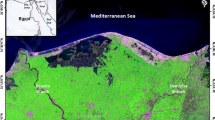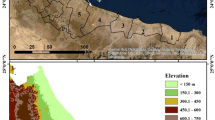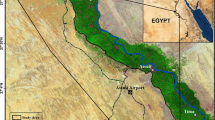Abstract
Land degradation is an environmental issue and it is described as the decrease of land stability. The available definitions of land degradation, methods to measure it, and the pertinent measures are diverse and controversial. Desertification and land degradation in Iran are serious issues and need assessment and survey to realize a stable land management in different regions of the country. The land degradation assessment in dryland (LADA) project has been initiated by the FAO over the past few years. The project is an attempt to introduce a set of standard methods and instructions to assess land degradation processes, the factors, and the effects with participation of local communities and users. The main objective of the present study is to assess land degradation and the effects on development and geomorphological forms in the west of Iran (Ilam Province) using LADA model. To do this, MODIS spectroradiometer (MOD13Q1 (250 m) NDVI) was used to examine trends of vegetation changes. In addition, LANDSET 7 & 8 data were used to assess change trend of surface water resources and salinity (BI, SI). The data provided by piezometer stations were used to examine change trend of groundwater resources and soil sample and measure EC and PH of the soil from 2000 to 2017. The results showed that land degradation has been expanding from the west to the east all over the region under study in terms of NDVI plant coverage during the time period under study. As illustrated by the images, vegetation degradation was more severe in the west and southwest of the region under study in sub-basins West/East Abbas Plane, Mosian, and Chenaneh, in the west of the region and sub-basins Abdanan, Dehloran, Mehran, and Salehabad in 2000, 2005, 2010, 2015, and 2017. Vegetation in these areas is low at all times. The change slope, change slope significance, 8-year predication of change trend, and vegetation change difference indices supported the findings. While changes in the surface water resources have been increasing with a slight slope due to construction of dams in the region, these changes have had no effect on preventing and controlling land degradation in the region, since these resources have been affected by the land degradation on the far west strip. Moreover, in terms of the groundwater resources level, out of 76 piezometric well, 49 well with negative water level changes and 27 well with positive water level changes were identified. This means that all the well with declining water level was on the west strip (sub-basins Mosian, Abdanan, Dehloran, and Mehran). However, ascending wells are mostly concentrated in in the sub-basins east and west of Dasht Abbas—i.e., the southwest of the region under study. The ascending water levels in these wells can be explained by expansion of Karkhe water grid and less demand for the ground water in the region. Salinity and brightness indices assessments and soil lab results showed the lands with maximum salinity index and 100% soil degradation were at the west strip of the region or the west and south of Ilam Province (Mehran, Mosian, Abdanan, West/East Dasht Abbas, and Moulab). Eventually, land degradation and its effects on formation of geomorphological forms in the region were examined. The results revealed that land degradation in the west and southwest strip of the region, where the degradation is critical, has created specific geomorphological forms such as gully erosion.






















Similar content being viewed by others
Notes
DPSIR is a causal framework for describing the interactions between society and the environment. This framework has been adopted by the European Environment Agency. The components of this model are: (Driving forces–Pressures–States–Impacts–Responses).
Combined spectral reflective Index.
Vegetation Soil Salinity Index.
References
Alijani B, Mahmoudi P, Chogan A (2011) Change trend in annual and seasonal precipitation in Iran using non-parametric method. Climatol Stud 3:1–3
Arun K, Vinod P, Deepak K, Poonam S (2008) R Development Core Team, a language and environment for statistical computing. R Foundation for Statistical Computing, Vienna, Austria. J Data Anal Inf Process 3:4–10
Badreldin N, Frankl A, Goossens R (2014) Assessing the spatiotemporal dynamics of vegetation cover as an indicator of desertification in Egypt using multi-temporal MODIS satellite images. Arab J Geosci 11:4461–4475
Bai ZG, Dent DL, Olsson L, Schaepman ME (2008) Global assessment of land degradation and improvement. Report 2008/01, ISRIC, Wageningen.
Barrow CJ (1991) Land Degradation: Development and Breakdown of Terrestrial Environments. Cambridge University Press, Cambridge, p 295
Barzani M, Khairulmaini OS (2013) Desertification risk mapping of the Zayandeh Rood Basin in Iran. J Earth Syst Sci 122:1269–1282
Brice JC (1966) Erosion and deposion in the loess-mantled Great plains, Medicine creek drainage basin, Nebraska: U.S. Geol. Survey prof paper 352-Hl, pp 255–335
Carlos C, Simon H, Michael A (2005) Millennium ecosystem assessment (MEA), ecosystems and human well-being: synthesis. World Resources Institute, Island Press, Washington DC
Chen L, Guo Z, Yin K, Shrestha DP, Jin S (2019) The influence of landuse and landcover change on landslide susceptibility: a case studyin Zhushan Town, Xuan’en County (Hubei, China). Nat Hazards Earth Syst Sci 19:2207–2228. https://doi.org/10.5194/nhess-19-2207-2019
Coppin P, Jonckheere I, Nackaerts K, Muys B, Lambin E (2004) Digital change detection methods in ecosystem monitoring: a review. International of thematic mapper data the TM tasseled cap. IEEE Trans Geosci Remote 25:1565–1596
Diouf A, Lambin E (2001) Monitoring land-cover changes in semiarid regions: remote sensing data and field observations in the Ferlo, Senegal. J Arid Environ 48:129–148
Drake NA, Vafeidis A (2004) A review of European Union funded research into the monitoring and mapping of Mediterranean desertification. Adv Environ Monit Modell 4:1–15
Dregne HE (2002) Land degradation in the drylands. Arid Land Res Manag 16:99–132
Eckert S, Fabia H, Hanspeter L, Elias H (2014) Trend analysis of MODIS NDVI time series for detecting land degradation and regeneration in Mongolia. J Arid Environ 113:185–197. https://doi.org/10.1016/j.jaridenv.2014.09.001
Fiorillo E, Fabio M, Vieri T, Patrizio V (2017) Analysis of land degradation processes on a tiger bush plateau in South West Niger using MODIS and LANDSAT TM/ETM+ data. Int J Appl Earth Obs Geoinf 62:56–68. https://doi.org/10.1016/j.jag.2017.05.010
Firouzi F (2018) Modeling time series of changes in the environmental elements of earth surface; case study: Sistan Plain. PhD dissertation, university of Sistan Baluchestan.
FAO (1977) Guideline for watershed management. Conservation Guide NO.1. Rome, Italy, FAO
Gabriela MA, Giorgio G, Maria TM, Salvatore V (2003) Study of land degradation and desertification dynamics in North Africa and Central Europe areas using Remote Sensing. In: Conference: 16th European seminar on geography of water – erasmus intensive programme on “Water management in coastal and insular Karst areas”, pp 1–11. https://doi.org/10.13140/RG.2.1.2412.6327
Gülersoy AE, Buldan E (2020) Relationships between geological-lithological characteristics and land-use in Gömec plain and immediate surroundings (Balikesir). Acad Soc Sci Stud J 79:337–354
Heed BH (1970) Morphology of gullies in the Colorado Rocky Mountains. Bull Int Assoc Sci Hydrol XV 2:79–89
Hürlimann M, Medina V, Guo Z, Puig-Polo C, Lloret A, and Vaunat J (2020). Impacts of future land cover and climate changes on landslide susceptibility. Results obtained from regional-scale modelling in the Pyrenees, EGU General Assembly 2020, Online, 4–8 May 2020, EGU2020-9327, https://doi.org/10.5194/egusphere-egu2020-9327
Imeson AC, Kwaad FJPM (1980) Gully types and gully predication. Geographic Tijdschrift XIV 5:430–441
Ireland HA, Sharpe CFS, Eargle DH (1939) Principle of gully erosion in the piedmont of South Carolina, USDA Technical Bulletin
Jamali S (2014) Analyzing vegetation trends with sensor data from earth observation satellites, supervisor professor Ronald Eastman, Doctoral Dissertation by due permission of the Faculty of Science, Lund University, Sweden, pp 160–1
Johnson DL, Lewis LA (1995) Land degradation: creation and destruction. Blackwell Publishers, Oxford
Johnson DL, Lewis LA (2007) land degradation: creation and destruction. Rowman and Littlefield, Lanham
Kundu NRA, Patel SK, Saha DD (2017) Desertification in western Rajasthan (India): an assessment using remote sensing derived rain-use efficiency and residual trend methods. Nat Hazards 86:297–313. https://doi.org/10.1007/s11069-016-2689-y
LADA (2009) Field manual for local level land degradation assessment in drylands. LADA part 1. Methodological approach, planning and analysis.
LADA Project Part1, Bunning S, McDonagh J, Rioux J (2016) Manual for local level assessment of land degradation and sustainable land management part 1 (Planning and methodological approach, analysis and reporting), FOOD AND AGRICULTURE ORGANIZATION OF THE UNITED NATIONS Rome, 2016, general coordinators Freddy Nachtergaele and Riccardo Biancalani FAO, Rome, Italy, pp 7–149. https://www.fao.org/3/as604e/as604e.pdf
Lantierei D (2003) Potential use of satellite remote sensing for land degradation assessment in drylands: application to the LADA project environment and natural resources service, sustainable development Department. FAO, Rome, pp 70–77
Lantierei D, Young A (2001) Report on the first LADA workshop. FAO, Rome
Licona-Manzur C, Nachtergaele FOF, Svensson L (2005) Indicator toolbox for the land degradation assessment in drylands project. UNCCD, COP-7 Side-event. Nairobi, Kenya.
Masoudi M, Amiri E (2015) A new model for hazard evaluation of vegetation degradation using DPSIR framework, a case study: Sadra Region. Iran Pol J Ecol 63:1–9
Menarid Projects (2014) The cost of land degradation and its effects on ES based on LADA model in Kermanshah Razin basin, Yazd Bahabad region, and Sistan and Baluchestan-Zabol region. http://www.menarid.ir/FileUpload/Editor/Documents/Studies/Land%20degradation%20trend%20assessment%20(Farsi).pdf. (in persian)
Mensah F, Adanu SK, Adanu DK (2015) Remote sensing and GIS based assessment of land degradation and implications for Ghana’s ecological zones. Environ Pract. https://doi.org/10.1017/S1466046614000465
Mshkhat MA (1998) temporary method to assess and prepare desertification map (FAO). For Pasture Res Org 10:1–12
Mushtak TJ, Ammar SD (2015) Evaluation of sandy land degradation based on geo-information techniques: a case study south part of Iraq. Int J Eng Invent 5:39–45
Nachtergaele F, Biancalani R, Bunning S, George H (2010) Land degradation assessment: the LADA approach, World Congress of Soil Science, Soil Solutions for a Changing World, pp 72–75. https://www.researchgate.net/publication/262561788
NASA (National Aerospace Authority) (2014) Moderate-resolution imaging spectroradiomet (MODIS). http://modis.gsfc.nasa.gov/about/media/modis_brochure.pdf. Accessed 27 May 2014
Nikpour N (2014) Geomorphological survey (morphotechnotic) of the midsection of Kabir Kuh anticline in Ilam Province (from Arishat frong to Imamzade Shah Mohammad Kuhneshin). Msc dissertation, University of Shahid Beheshti.
Poesen J (1993) Gully typology and gully control measures in the European loess belt. In: Wicherek S (ed) Farm land erosion in temperate plains environment and hills. Elsevier Science Publishers, Amsterdam, pp 221–39
Prince SD (2002) Spatial and temporal scales for detection of desertification. Global desertification: do humans cause deserts. Dahlem University Press, Berlin
Rahdari GR, Rahdari MR, Fakhireh AA, Shahryari AR, Khosravi H (2013) GIS-based Monitoring and EWSs of desertification (case study; southeastern of Iran). Int J Adv Biol Biomed Res 10:1185–1198
Rosgen DL (2004) A classification of natural rivers. Catena 22:169–199
Salvati L, Zitti M (2008) Regional convergence of environmental variables: empirical evidences from land degradation. Ecol Econ 68:162–168
Semendereoğlu A, Gülersoy A, İlhan A (2014) Fiziksel arazi degredasyonu. Türk Coğrafya Dergisi 0(47):75–98
Sepehr A, Hassanli AM, Ekhtesasi R, Jamali JB (2006) Quantitative assessment of desertification in south of Iran using MEDALUS method, 1–13. DOI. https://doi.org/10.1007/s10661-007-9613-6
Sudhakar RC, Saranya KRL, Vazeed PS, Satish KV, Jha CS, Diwakar PG, Dadhwal VK, Rao PVN, Krishna Murthy YVN (2018) Assessment and monitoring of deforestation and forest fragmentation in South Asia since the 1930s. Glob Planet Change 161:148–132. https://doi.org/10.1016/j.gloplacha.2017.10.007
Svenson L (2005) Socio-economic indicators for causes and consequences of land degradation. LADA Technical paper, FAO, Rome.
Temesgen G, Amare B, Abraham M (2014) Evaluations of land use/land cover changes and land degradation in Dera district, Ethiopia: GIS and remote sensing based analysis. Int J Sci Res Environ Sci 2(6):199–208. https://doi.org/10.12983/ijsres-2014-p0199-0208
UNEP/FAO/UNDP (1994) Land Degradation in South Asia: Its severity Causes and effects upon the People NEP/FAO/UNDP, FAO World Soil Resources Report 78 FAO Rome
Valentin C, Poesen J, Yong L (2005) Gully erosion impact, factor and control. CATENA 63:1–10
Vandandorj S, Gantsetseg B, Boldgiv B (2015) Spatial and temporal variability in vegetation cover of Mongolia and its implications. J Arid Land 7:20–36
Warren A (2002) Land degradation is contextual. Land Degrad Dev 13:449–459
Waswa BS (2012) Inaugural-dissertation, assessment of land degradation patterns in Western Kenya: implications for restoration and rehabilitation, Rheinischen Friedrich-Wilhelm's-Universidad zu Bonn, pp 1–220. https://bonndoc.ulb.unibonn.de/xmlui/bitstream/handle/20.500.11811/5139/3077.pdf?sequence=1&isAllowed=y
Wessels KJ, Prince SD, Frost PE, van ZD, (2004) Assessing the effects of humaninduced land degradation in the former homelands of northern South Africa with a 1 km AVHRR NDVI time-series. Remote Sens Environ 91:47–67
Weston A, Timothy J (2016) Evaluating global land degradation using ground-based measurements and remote sensing, Department of Earth and Environmental Sciences, Columbia University. Springer, Cham, pp 85–116. https://doi.org/10.1007/978-3-319-19168-3_5
Yahaya Z, Ibrahim HB, Jörg K, Compton J, Tucker CJ (2015) Land degradation assessment using residual trend analysis of GIMMS NDVI3g, soil moisture and rainfall in sub-Saharan West Africa from 1982 to 2012. J Remote Sens. https://doi.org/10.3390/rs70505471
Yahaya ZI (2017) Thesis(MSc) Vegetation and land cover change in the context of land degradation in sub-Saharan West Africa, Thesis submitted for the degree of Doctor of Philosophy at the University of Leicester, pp 1–179
Zhang J, Niu JM, Bao T, Buyantuyev A, Zhang Q, Dong JJ (2014) Human induced dryland degradation in Ordos Plateau, China, revealed by multilevel statistical modeling of normalized difference vegetation index and rainfall time-series. J Arid Land 6:219–229
Acknowledgements
This study was supported by the Iran National Science Foundation (Projects No. 97012440).
Funding
This research was funded by Iran National Science Foundation, Grant no [97012440].
Author information
Authors and Affiliations
Corresponding author
Ethics declarations
Conflict of interest
The author declare no conflict of interest.
Additional information
Publisher's Note
Springer Nature remains neutral with regard to jurisdictional claims in published maps and institutional affiliations.
Rights and permissions
About this article
Cite this article
Nikpour, N., Fotoohi, S., Hosseini, S.Z. et al. An assessment of land degradation and its effects on geomorphology using LADA model: a case study of Ilam Province, west of Iran. Environ Earth Sci 81, 274 (2022). https://doi.org/10.1007/s12665-022-10292-1
Received:
Accepted:
Published:
DOI: https://doi.org/10.1007/s12665-022-10292-1




